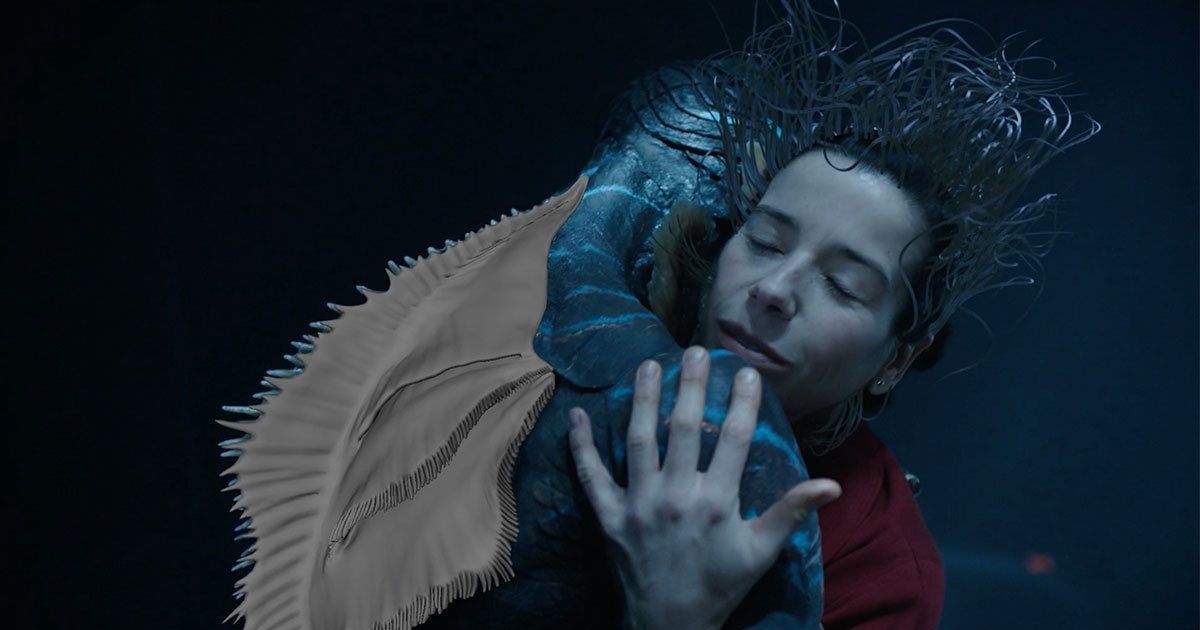The “Shape of Water,” Guillermo del Toro’s 2017 masterpiece, is a film that lingers in the mind long after the credits roll. Its tender, forbidden love story transcends the boundaries of conventional romance. But it is the film’s iconic love scene – a moment of exquisite intimacy and shared vulnerability – that truly captivates audiences. This scene, set in a softly lit bathroom, is not just a physical act; it is a testament to the boundless power of love, a poignant statement on empathy and acceptance, and a testament to the artistic vision of its director.

Image: www.youtube.com
Exploring the layers of symbolism and subtle nuances within this single scene reveals a fascinating tapestry of artistic intention. Del Toro’s deliberate choices – from the set design to the film’s score – combine to create an evocative atmosphere that amplifies the emotional weight of the moment. This article dives into the “Shape of Water” love scene, dissecting its visual elements, its narrative implications, and the profound symbolism it embodies.
Beyond the Surface: Embracing the Unconventional
The love scene in “Shape of Water” is anything but conventional. It presents a love story between a mute woman, Elisa (Sally Hawkins), and a captured amphibian creature, a being ostracized and feared by society. This unconventional pairing instantly challenges societal norms, forcing the viewer to confront their own preconceived notions about love and acceptance.
Del Toro’s masterful direction amplifies the strangeness of the situation, not to exploit, but to emphasize the raw, uncomplicated beauty of Elisa and the Amphibian Man’s connection. He uses close-up shots of their faces to highlight their shared vulnerability, their gazes locked in an unspoken understanding. The water, a recurring motif throughout the film, becomes a crucial element in the love scene, a symbol of both cleansing and intimacy.
A Dance of Empathy: Breaking Down Barriers
The love scene is not solely about physical intimacy; it is a powerful statement on the nature of empathy. Elisa, with her own struggles with communication and societal isolation, understands the Amphibian Man’s pain. She sees beyond his appearance, recognizing the depth of his soul. The scene unfolds slowly, a testament to the painstaking process of building trust between two beings so fundamentally different.
The gentle touch, the unspoken communication, the way Elisa patiently removes the Amphibian Man’s mask – these actions all speak to the foundation of their bond. There’s a sense of complete surrender to this love, a vulnerability that further underlines the scene’s powerful message: love transcends superficiality and embraces difference.
The Power of Visual Storytelling: A Symphony of Images
The visual elements in the love scene are crucial to its impact. The muted color palette, the soft lighting, the deliberate use of space all contribute to the scene’s intimate and ethereal quality. The scene’s choreography is particularly notable; Elisa’s movements are graceful and deliberate, echoing the fluidity of water and mirroring the Amphibian Man’s graceful movements.
Del Toro’s use of close-ups, particularly during the scene’s climax, intensifies the viewer’s emotional response. We see every subtle expression on Elisa’s face, every flicker of vulnerability in the Amphibian Man’s eyes. The camera lingers on their bodies, emphasizing the tenderness of their touch, the way their physical differences merge into a harmonious unity.

Image: scroll.in
Beyond the Physical: A Love Story of the Soul
The “Shape of Water” love scene is not just about sex; it is a profound exploration of the soul. The scene’s climax, with Elisa and the Amphibian Man entwined in the bathtub, is a moment of utter bliss, a manifestation of their shared vulnerability. The scene is not explicit, yet it is profoundly sensual, a testament to the power of non-verbal communication and the depth of emotional connection.
At this pivotal moment, the scene transcends the physical. The music swells as Elisa and the Amphibian Man gaze into each other’s eyes, their bodies becoming one. This is love in its purest form, a love untainted by societal expectations, a love that acknowledges the soul’s yearning for connection.
Del Toro’s Vision: A Love Story for the Ages
Guillermo del Toro’s masterful direction is evident in every aspect of the “Shape of Water” love scene. He constructs a scene that is both visually stunning and emotionally resonant. Del Toro understands the power of silence, he understands the language of the body, he understands the depths of human desire. This love scene transcends the boundaries of genre; it becomes a powerful allegory for acceptance, a celebration of the human spirit’s resilience.
The scene’s artistry lies in its ability to evoke a multitude of emotions. It is a scene that is both tender and poignant, heartbreaking and hopeful. It is a scene that lingers in the mind, a testament not only to the power of love but also to the power of cinema to move, challenge, and inspire.
The Shape Of Water Love Scene
The “Shape of Water” Love Scene: A Legacy of Love
The “Shape of Water” love scene is a cinematic landmark. It is a scene that has resonated with audiences worldwide, a scene that has sparked conversations about love, acceptance, and the beauty of difference. It is a scene that stands as a testament to the power of cinema to elevate the human experience, to challenge our preconceptions, and to remind us of the transcendence of love.
In its unconventional beauty, the “Shape of Water” love scene serves as a potent reminder that love can blossom in the most unexpected places, in the most improbable forms. Explore the film, delve into its layers, and experience the transformative power of love firsthand.






